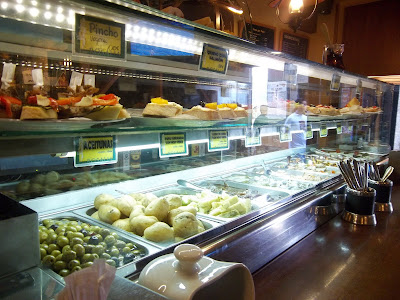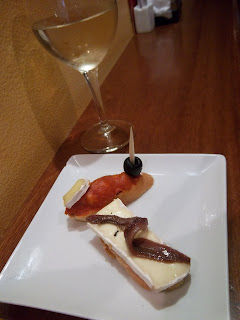A Guide to Camino: Food, Part 3
Atun—Tuna was probably the meat you ate most in Spain. Little tins of tuna made great lunches along the road; tuna melts for lunch if there was a kitchen in the albergue; tuna on the ensalada mixta; and when you got to Galicia, empanada atun (a thin tuna pie) was your favorite snack to pick up at a bar.
Ensalada mixta, a common starter, with tuna
Meat—"For a vegetarian, you really like meat," the Belgian once told you as you were digging into some of the best chicken you ate on the Camino. You explained to him that walking 30 k a day made you need lots of protein, and Spain wasn't exactly overflowing with beans and nuts. You ate what was available. If huevos fritos, fried eggs, were on the menu for the pilgrim's entree, you almost always took it.
Home cookin'—If there's a supermercado in the town and a kitchen in the albergue the pilgrim's can cook dinner for themselves. More and more often along the Camino this is what you do. Pasta is common, easy to make for large groups. Your first home-cooked meal was made by a German, pasta for 12 pilgrims, with fried onions and garlic and red peppers, with tomato salsa and shaved mozzarella. You were thrilled. Another time a Danish woman made you a sort of alfredo with tuna and dill. The Belgian always made Spanish eggs. On your night to cook you made the Belgian grilled sandwiches, because he became extremely confused every time you talked about this American habit of frying sandwiches or offered him a tuna melt. You caramelized onions with red peppers and garlic, added tomatoes and cheese and ham (the Belgian wanted meat), put it between slices of bread and fried it in butter.
Spanish eggs—The Belgian always made these because they were fairly easy. He said they were college food. The last night, while you were breaking up for the last time, he made them for you because he knew you liked eggs. He would scramble eggs with tomatoes, ham, cheese, onions, garlic, and butter. When asked what made them Spanish, he said it was how heavy they were, the cheese and butter, no milk or water to cut the eggs.
Vinagre y sal—Every night when the camarero brought your entrees to the table, you would say, "Vinagre, por favor," and the Belgian would say, "y sal." Patatas fritas, French fries, came with most meals. The Spanish don't salt their food much, not even French fries, and ketchup was uncommon, forcing you to kick that habit. But you were introduced to vinegar on French fries by a Finish woman and Pennsylvanian man, and loved it.
The entree of a pilgrim's menu: rabas (calamari) patatas fritas, pimientos, and bread soaked with oil and vinegar.
Tarta de queso—Cheese cake. In Galego, tarta de queixo. It really isn't like American cheesecake, and you're not sure they even use cream cheese. It's much eggier, but when done right very good.
The window of a delicatessen in Santiago, with tarta de queixo on the left.
Tinto de verano—Most commonly half red wine and half lemonade. Very refreshing.
Croquetas—Creamy potato business, sometimes with cheese or bits of ham, breaded and fried. They're like little potato pills. They were one of your favorite snacks at bars.
Tapas—You at first found all this pinchos, raciones, and tapas business confusing. Even now, you're not really sure if pinchos and tapas are the same thing. Pinchos were small bits of food, just a few bites, usually under glass on the bar. Pinchos often came on toast, you even once saw croquetas on toast. Raciones were larger, such as a plate of gambas (shrimp) or pimientos de padron or cheese. At some bars they would give you a pincho every time you ordered a new drink, a small plate of olives, or a mussel on toast, or a slice of tomato and cheese on toast, or a couple bites of tortilla. In bigger cities like Pamplona and Santiago you liked to bar hop so you could try a pincho or two at each one. Shrimp salad on toast, sweet peppers and sardines on toast, a small piece of empanada filled with chorizo and potato.
A case of pinchos at a bar in Santiago
Pinchos: Smoked salmon and blackberries in cream cheese, salchichon.
Pinchos with a glass of Ribeiro, the best white wine in Galicia
More pictures:
Queso con miel, cheese with honey that was the postre (dessert) with the ensalada mixta and calamari previously shown
Cafe con leche
Arroz con leche, rice pudding, a postre for pilgrim's menus









These all look like things we should try at home, are you ready to have Spanish food week in the Northwest? I know we can find some salmon and blackberries somewhere...
ReplyDelete